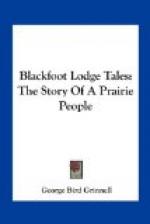“This,” said Old Man, “will be the first time it has happened to the people. You have seen the buffalo fall to the ground when struck with an arrow. Their hearts stop beating, they do not breathe, and soon their bodies become cold. They are then dead. Now, woman, it shall be for you to decide whether death shall come to the people as well as to the other animals, or whether they shall live forever. Come now with me to the river.”
When they reached the water’s edge, Old Man picked up from the ground a dry buffalo chip and a stone. “Now, woman,” he said, “you will tell me which one of these to throw into the water. If what I throw floats, your child shall live; the people shall live forever. If it sinks, then your child shall die, and all the people shall die, each one when his time comes.”
The woman stood still a long time, looking from the stone to the buffalo chip, and from the chip to the stone. At last she said, “Throw the stone.” Then Old Man tossed it into the river, and it sank to the bottom. “Woman,” he cried, “go home; your child is dead.” Thus, on account of a foolish woman, we all must die.
The shadow of a person, the Blackfeet say, is his soul. Northeast of the Sweet Grass Hills, near the international boundary line, is a bleak, sandy country called the Sand Hills, and there all the shadows of the deceased good Blackfeet are congregated. The shadows of those who in this world led wicked lives are not allowed to go there. After death, these wicked persons take the shape of ghosts (Sta-au’[1]), and are compelled ever after to remain near the place where they died. Unhappy themselves, they envy those who are happy, and continually prowl about the lodges of the living, seeking to do them some injury. Sometimes they tap on the lodge skins and whistle down the smoke hole, but if the fire is burning within they will not enter.
[Footnote 1: The human skeleton is also called Sta-au’, i.e. ghost. Compare Cheyenne Mis-tai’, ghost.]
Outside in the dark they do much harm, especially the ghosts of enemies who have been killed in battle. These sometimes shoot invisible arrows into persons, causing sickness and death. They have hit people on the head, causing them to become crazy. They have paralyzed people’s limbs, and drawn their faces out of shape, and done much other harm. Ghosts walk above the ground, not on it. An example of this peculiarity is seen in the case of the young man who visited the lodge of the starving family, in the story entitled Origin of the I-kun-uh’-kah-tsi.
Ghosts sometimes speak to people. An instance of this is the following, which occurred to my friend Young Bear Chief, and which he related to me. He said: “I once went to war, and took my wife with me. I went to Buffalo Lip Butte, east of the Cypress Mountains; a little creek runs by it. I took eighteen horses from an Assinaboine camp one night, when it was very foggy. I found sixteen




